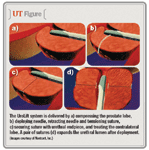Article
Minimally invasive technology for lower urinary tract symptoms safe, efficacious
A novel minimally invasive system for the treatment of lower urinary tract symptoms due to BPH appears to be safe and efficacious for as long as 2 years after the procedure is performed.
San Francisco-A novel minimally invasive system for the treatment of lower urinary tract symptoms due to BPH appears to be safe and efficacious for as long as 2 years after the procedure is performed, according to results of a multicenter study presented at the AUA annual meeting in San Francisco.

For the study, 55 patients with bladder outlet obstruction were treated at six centers. Primary endpoints were feasibility and safety, and secondary endpoints were decrease in LUTS (as measured by International Prostate Symptom Score), quality of life score, and BPH Impact Index (BPH II), as well as sexual health, as measured by International Index of Erectile Function (IIEF) and Male Sexual Health Questionnaire–Ejaculatory Dysfunction. Flow, residual volume, and sexual health parameters were also collected.
The procedure had a 100% completion success rate and was well tolerated with local anesthesia. At 2-week follow-up, mean IPSS was 13.8 compared to 22.8 at baseline (p<.001); at 12 months, IPSS declined from 22.0 to 12.0 (p<.001), and at 24 months, from 21.1 to 13.2 (p<.01).
Improvement in flow was also observed; mean maximum flow rate improved from 7.6 mL/sec at baseline to 10.2 mL/sec at 12 months (p<.05). No incidence of retrograde ejaculation was observed, and ejaculatory function improved throughout follow-up. Mean IIEF went from 34 at baseline to 45 at 12 months (p<.05).
The most frequent adverse events were dysuria (78%), hematuria (67%), and frequency (27%). Four patients had related serious adverse events that required hospital admission. Adverse events typically resolved within 2 weeks.
The UroLift is unique among therapies for LUTS in that it is mechanical and not heat-based, Dr. Woo said.
"It differs from most minimally invasive therapies in that it doesn't rely upon thermal energy to achieve its effect," Dr. Woo explained.
The UroLift uses an endoscopic delivery device to introduce a hollow needle that projects beyond the capsule. When the needle is retracted, a clip-like structure that is left behind is attached to a monofilament suture. The suture is placed under tension, and a second clip is slid up the suture, which is cut to be flush to the clip.
The result is a lifting of prostatic tissue away from the lumen. This is typically performed four times in patients, Dr. Woo said.
Dr. Woo said the procedure can be performed within 5 to 10 minutes and has the potential to be performed in the office.
"This is an incredibly easy technology," Dr. Woo told Urology Times. "It's about as close as you get to see one, do one, teach one."
He said a phase III trial of UroLift is planned.
Dr. Woo and several of his co-authors serve as clinical advisers to NeoTract, Inc., which provided funding for the study.





